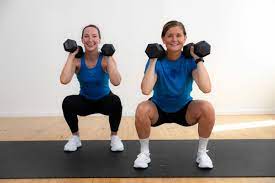The Benefits of Strength Exercises at Home
Strength training is an essential component of a well-rounded fitness routine. Building strength not only helps you look and feel better but also improves your overall health and functional abilities. The good news is that you don’t need a gym membership or fancy equipment to incorporate effective strength exercises into your daily routine. Here are some benefits of doing strength exercises at home:
Convenience
One of the biggest advantages of working out at home is the convenience it offers. You can exercise anytime, without having to commute to a gym or adhere to their operating hours. This flexibility makes it easier to establish a consistent workout routine that fits into your schedule.
Cost-Effective
Gym memberships and personal training sessions can be expensive. By opting to do strength exercises at home, you can save money on membership fees and invest in basic equipment like dumbbells or resistance bands that are relatively affordable and versatile.
Privacy and Comfort
Exercising in the comfort of your own home provides privacy and eliminates any self-consciousness you may feel when working out in a public setting. You can focus on your form and technique without feeling judged by others, creating a more relaxed and enjoyable workout environment.
Effective Workouts
You might be surprised by the variety of effective strength exercises you can do at home with minimal equipment. Bodyweight exercises like squats, push-ups, planks, lunges, and burpees target multiple muscle groups and can be modified to suit different fitness levels. Additionally, incorporating household items like water bottles or chairs can add resistance to your workouts.
Tips for Success
- Create a dedicated workout space in your home with enough room to move freely.
- Set specific goals for your strength training program to track progress and stay motivated.
- Vary your workouts by changing exercises, reps, sets, and intensity levels to prevent plateaus.
- Stay hydrated, eat a balanced diet rich in protein, and get adequate rest for optimal recovery.
- Consult with a fitness professional if you’re new to strength training or have specific health concerns.
In conclusion, incorporating strength exercises into your home workout routine is a convenient, cost-effective, and efficient way to improve your physical fitness and overall well-being. With dedication and consistency, you can achieve significant results without ever leaving the comfort of your own home.
5 Essential Tips for Effective Strength Training at Home
- Start with bodyweight exercises like push-ups, squats, and planks.
- Use household items like water bottles or backpacks filled with books as weights.
- Focus on proper form to prevent injuries and maximize results.
- Incorporate resistance bands for added challenge and variety in your workouts.
- Don’t forget to warm up before exercising and cool down afterwards to aid in recovery.
Start with bodyweight exercises like push-ups, squats, and planks.
To kickstart your home strength training routine, begin with bodyweight exercises such as push-ups, squats, and planks. These fundamental exercises engage multiple muscle groups simultaneously, providing a solid foundation for building strength and improving overall fitness. Push-ups target the chest, shoulders, and triceps while squats work the quadriceps, hamstrings, and glutes. Planks strengthen the core muscles essential for stability and posture. By mastering these basic movements first, you can gradually progress to more challenging exercises and variations to continue challenging your muscles and achieving your fitness goals.
Use household items like water bottles or backpacks filled with books as weights.
To enhance your strength training routine at home, you can get creative by using household items such as water bottles or backpacks filled with books as makeshift weights. These everyday objects can add resistance to exercises like squats, lunges, or bicep curls, allowing you to effectively target and challenge your muscles without the need for specialized equipment. This simple yet resourceful approach not only saves money but also adds variety to your workouts, making it easier to stay motivated and engaged in your fitness regimen.
Focus on proper form to prevent injuries and maximize results.
Focusing on proper form during strength exercises at home is crucial to both prevent injuries and maximize results. By maintaining correct posture and technique, you not only reduce the risk of strains or muscle imbalances but also ensure that the targeted muscles are effectively engaged. Proper form allows for a more efficient workout, enabling you to fully reap the benefits of each exercise and progress towards your fitness goals safely and effectively. Remember, quality over quantity – prioritize good form over the number of repetitions to optimize your strength training routine.
Incorporate resistance bands for added challenge and variety in your workouts.
To enhance the effectiveness and variety of your home workouts, consider incorporating resistance bands. These versatile tools provide an added challenge to your strength exercises by creating resistance throughout the full range of motion. Whether you’re performing squats, rows, or shoulder presses, resistance bands can target specific muscle groups and help increase overall strength and endurance. By incorporating resistance bands into your routine, you can add a new dimension to your workouts and continue to progress towards your fitness goals.
Don’t forget to warm up before exercising and cool down afterwards to aid in recovery.
To maximize the benefits of your strength exercises at home, remember to prioritize your warm-up and cool-down routines. Warming up before your workout helps prepare your muscles, joints, and cardiovascular system for the upcoming activity, reducing the risk of injury and improving performance. Similarly, cooling down after exercising allows your body to gradually return to its resting state, aiding in muscle recovery and reducing post-workout soreness. By incorporating proper warm-up and cool-down practices into your routine, you can enhance the effectiveness of your strength training sessions and promote overall fitness progress.




